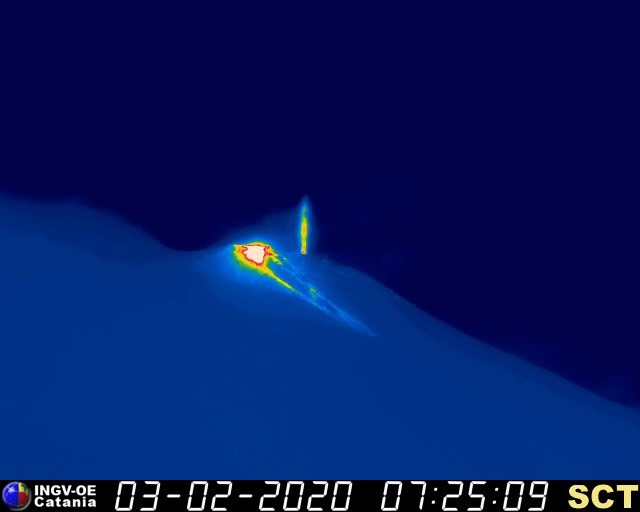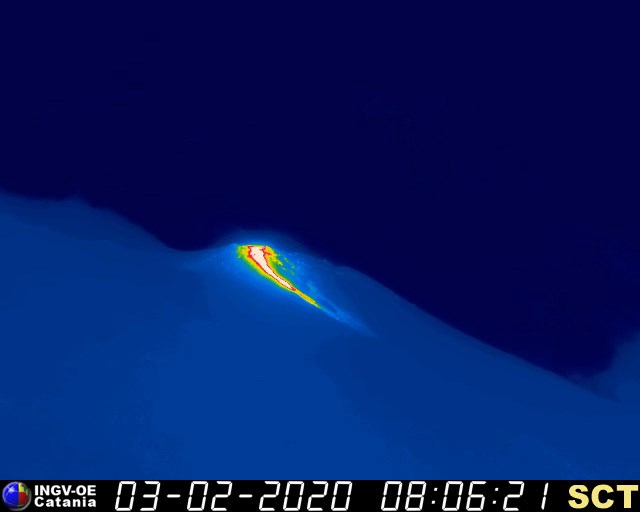Lava overflows Stromboli’s crater terrace, Italy

Lava is overflowing the northern portion of Stromboli's crater terrace, INGV Osservatorio Etneo reported at 10:13 UTC on February 3, 2020.
Lava overflow, currently small and confined to the summit area, started at about 07:20 UTC today.
"The lava flow front disintegrates on the steep slope, sending rock material rolling down the Sciara del Fuoco," INGV noted.
Meanwhile, the volcanic tremor amplitude shows no significant variations associated with the lava overflow.
The images below are captured from video recorded by the new thermal camera installed at 190 m (625 feet) elevation on the northern rim of the Sciara del Fuoco, at 07:25 and 08:06 UTC on February 3, 2020.


A major paroxysmal eruption took place at the volcano at 10:17 UTC on August 28, 2019, affecting the central-southern area of the crater terrace. The products generated by the explosion spread throughout the terrace and along the Sciara del Fuoco, rolling down to the coastline.
The Aviation Color Code has been raised to Red.
"For the moment it is highly unlikely that there will be excursions onto the summit of Stromboli anytime soon. The whole handling of tourism on this volcano will certainly be thoroughly reviewed. With explosions like those of July 3 and today, there would have been no chance of survival for anybody at the summit," INGV's Boris Behncke said at the time.
— Anil Charley (@CharleyAnil) July 3, 2019
The vulcano #Stromboli just erupted. Never seen something like that. pic.twitter.com/YmPnwaWRVC
— Carmelo Saia (@SaiaCarmelo) July 3, 2019
Volcano on #Italy's Mediterranean island of #Stromboli erupts, frightening locals and tourists residing on the island and nearby resorts pic.twitter.com/1FTUcVM0K8
— EHA News (@eha_news) July 3, 2019
Leaving #stromboli I’ve never feel so much fear in my life. pic.twitter.com/j33oo3FKKL
— n-il (@nil87739678) July 3, 2019
#Stromboli eruptions: panic among tourists!https://t.co/pTcqzHYVl8 pic.twitter.com/wESpXdRetX
— SkylineWebcams (@SkylineWebcams) July 3, 2019
Geological summary
Spectacular incandescent nighttime explosions at this volcano have long attracted visitors to the "Lighthouse of the Mediterranean."
Stromboli, the NE-most of the Aeolian Islands, has lent its name to the frequent mild explosive activity that has characterized its eruptions throughout much of historical time. The small, 924-m-high (3 031 feet) island is the emergent summit of a volcano that grew in two main eruptive cycles, the last of which formed the western portion of the island.
The Neostromboli eruptive period from about 13 000 to 5 000 years ago was followed by formation of the modern Stromboli edifice. The active summit vents are located at the head of the Sciara del Fuoco, a prominent horseshoe-shaped scarp formed about 5 000 years ago as a result of the most recent of a series of slope failures that extend to below sea level.
The modern volcano has been constructed within this scarp, which funnels pyroclastic ejecta and lava flows to the NW. Essentially continuous mild strombolian explosions, sometimes accompanied by lava flows, have been recorded for more than a millennium. (GVP)
Featured image credit: Nicole Bremner (@NicoleBremner)

Commenting rules and guidelines
We value the thoughts and opinions of our readers and welcome healthy discussions on our website. In order to maintain a respectful and positive community, we ask that all commenters follow these rules.